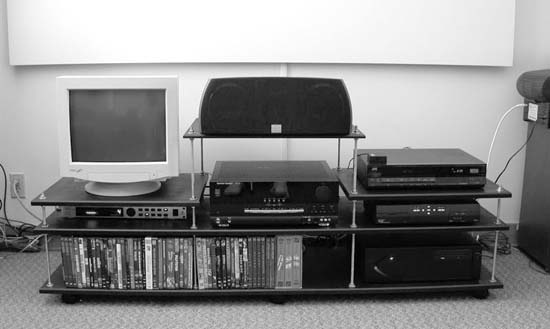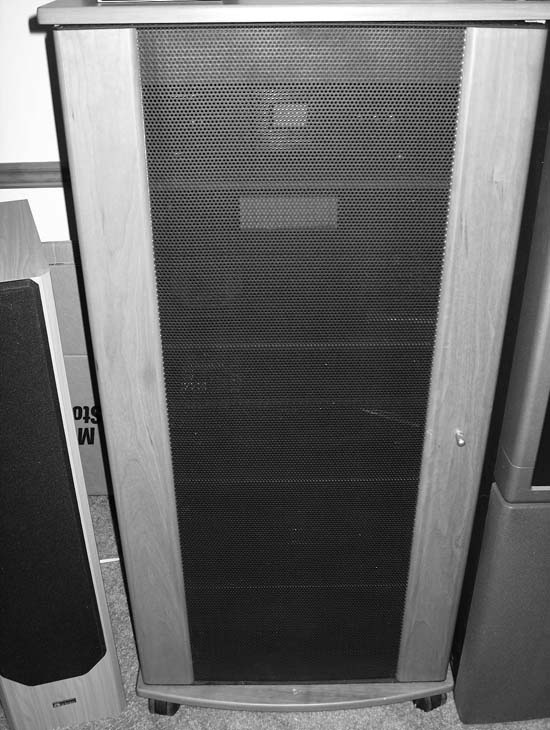Purchase the best cabinets you can afford for your gear to ensure that it runs as cool as possible, and looks good doing it.
Let's face it: gear is expensive. You easily can spend $20,000 on a good home theater over the course of a couple of years, and that's still leaving plenty of room to upgrade. But that gear isn't worth much, if you never let anyone listen to it. So, here's the common scenario: you invite your friends over for the "ultimate" movie experience. But instead of being in awe of the sound and picture, the first comment you hear is "Geeâ¦why's it all just sitting out on the floor?" Not a pretty picture, is it? One of the most important purchases you'll make, in going from cool gear to cool theater, are cabinets. You'll be able to organize your gear, tuck it away neatly, keep the cable situation under control, and look high-end, all for a fraction of what you've already dropped into the black hole which is your home theater expense sheet.
If you've squeezed out every penny to get what you could in terms of equipment, you might have to begin with a lower-end solution than nice wood cabinets. With a decent set of tools and some effort, you actually can put together a nice set of component shelves. Unless you're Bob Vila, you probably won't have hinged doors, custom-fit racks, and the like, but it's still a lot better than a $5,000 receiver sitting on a cardboard box.
Purchase some medium-density fiberboard (MDF) from Home Depot or Lowe's, and cut it to size. For a nicer look, bevel the edges (this will make your shelves look much more expensive!). Then drill holes and run rods through the holes to create a support structure. Connect the whole thing with your basic bolts and washers, and you're done! For extra support, especially on carpets, add some casters to the bottom shelves to level things out. As an example of this sort of setup, check out Figure 1-12; it should give you some ideas.
Be sure you heavily prime the MDF, especially if you're painting the shelves black, to ensure a nice matte finish. I've also heard of folks lining the shelf tops with truck bed liner for extra tractionâgo figure! In any case, I've not gone into detail because most of you will want to jump to the higher-end cabinets as quickly as possible, especially if you've got bigger TV sets.
When you've decided to move up from the homemade equipment, you have two basic options available to you: custom shelving and store-bought home theater racks.
Tip
If you happen to be into woodworking, that obviously is a third option, but you'll find it takes many hours to put together a top-notch home theater cabinet. This is more than just shelves and dowel rods; you need to take into account cooling, some sort of door or enclosure, rear openings for cables, and a lot more. Go for it if you like, but take plenty of time to plan ahead.
The most custom solution is to find a local carpenter, and have her put in shelving. This is a killer option, as you can tailor the shelving and cabinetry to your specific needs. You'll also be able to mount the shelving in a closet or on a wall, if you've got the space, which provides a really clean, integrated-looking system. The downside, though, is that you'll often get a carpenter who doesn't know a thing about audio and video gear. You'll have to walk her through proper ventilation and your cable system. Keep in mind that you need access to the rear of your equipment for cable checks, calibration, and the inevitable upgrade. If you can't find someone who has already done a few similar installations, you should exercise caution, lest you end up with really expensive bookshelves!
The second optionâthe road most takenâis to buy cabinets. Just skip right over eBay and chain stores for this, though, as you'll be dissatisfied. You should check out Videogon first; it has a section just for this category: http://cgi.videogon.com/cgi-bin/fs.pl?furncabi. Unfortunately, it's still somewhat undersized; nonetheless, you might find just what you need there.
If Videogon fails, search Google for "home theater cabinets." You'll get a slew of results to wade through and check out.
Tip
I've purposefully omitted specific sites, as I've found that the most reliable locations seem to change every few months. What worked for me might not work for you six or nine months down the line.
Personally, I recommend wood cabinets (see Figure 1-13), as metal just doesn't appeal to my eye. You'll also save a bundle in shipping wood as opposed to metal. I also urge you to overbuy; if you have 10 components, look for a unit with at least 12 shelves; you never know when you'll find the next piece of must-have equipment, and you want room to add it into your system. Also, ensure the shelves are adjustable. All components are not created equally!
In the same vein, please, please measure your components! I can't tell you how many horror stories I've heard of someone buying shelves that their gear didn't fit into, and having to spend more than a hundred bucks to ship back the cabinets. Get the widest component you have, and record its width. Also get the height of your tallest component, and the depth of your deepest component. Then, ensure you get the interior measurements of the cabinets you're looking at, and ensure things will fit. I always add at least two inches to my requirements to ensure a comfy fit and room for cables and the like.
As a last piece of advice, I recommend you find home theater cabinets at a furniture-style shop rather than the other way around. I find that the stores that major in cabinetry have better and sturdier cabinets than the home theater stores. This is a big enough market these days that this shouldn't be an issue, but watch out anyway.
One of the big draws for cabinets these days is cable management. This is usually marketing jargon for a set of conduits through which you can run your cables, supposedly hiding them from view. The problem is that, even in the high-end gear, these conduits are small. You'll spend hours threading cables through one end, hoping (praying!) that the cables will make it out the other end. And, once you get even a few cables threaded through, things get really complicated. I've yet to see a unit with larger cable runs, and honestly, if the conduit were big enough to be useful, it probably would look obnoxious anyway!
As if that's not bad enough, when you have a problem, you'll be ready to murder someone once you realize you've got to mess with cables, so carefully run through those little conduits (I'm getting frustrated just thinking about it). The best cable management involves a little Velcro [Hack #36] , not expensive routing.
A final word on racks before you spend your hard-earned money. Under no circumstances should you ever buy glass shelves. I say that with great reluctance because some of the coolest setups you'll ever see are built out of glass; in fact, I once spent almost $900 on two glass component racks. The problems, though, are many.
- Dust
I mean, it gets on everything, you can't hide it, and it's constantly blowing up off of the (often static electricity-charged) glass shelves.
- Clarity
You might think clear glass is cool, but it doesn't hide anything. Your one silver component suddenly jumps out of the rack, while all of its black-finished neighbors hide. This gets really annoying after the fifth time someone asks you "Now, why didn't you get a black DVD player?"
- Cable management
What a mess: if you can't hide a silver component, imagine the quite visible mess of component, coaxial, RGB, and other cables that litter your racks.
I've yet to find a single rack with glass shelves that addresses even one of these issues, let alone all three. And, to add insult to injury, the glass racks are usually more expensive! So, save your money (and sanity) and stick with wooden shelves (or, if you prefer, metal).
Get Home Theater Hacks now with the O’Reilly learning platform.
O’Reilly members experience books, live events, courses curated by job role, and more from O’Reilly and nearly 200 top publishers.



